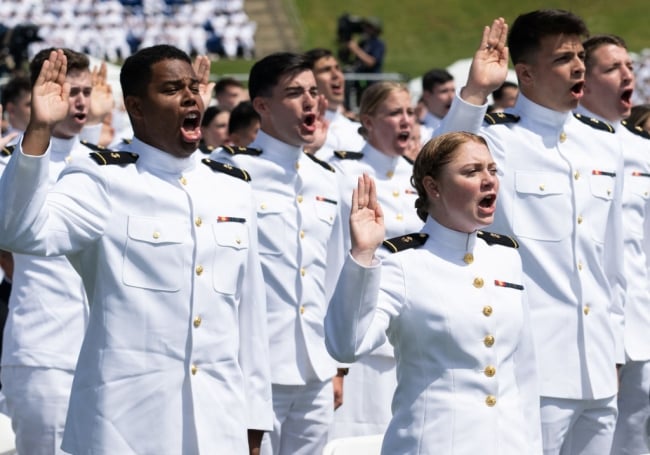You have /5 articles left.
Sign up for a free account or log in.

Members of the U.S. Naval Academy Class of 2023 at graduation that May. The academy is currently on trial in Baltimore over its race-conscious admissions practices.
Saul Loeb/AFP via Getty Images
A little over a year after winning an end to affirmative action at the Supreme Court, Students for Fair Admissions is back in the courtroom. Yesterday marked the first day of trial in the group’s case against the U.S. Naval Academy before a federal judge in Baltimore.
It’s the latest legal battle over the still-blurry contours of summer 2023’s Supreme Court ruling, which struck down the practice at nearly all colleges and universities. For SFFA, the key word there is “nearly.”
In a footnote attached to his vague and at times self-contradictory majority opinion, Chief Justice John Roberts specifically excluded military academies from the affirmative action ban, citing their “potentially distinct interests” in enrolling a racially diverse student body—namely, to diversify the officer corps of the U.S. military. But the court did not close off the possibility that the decision would be expanded to military institutions later; rather, the justices left the question open—just as they did questions about whether it would apply to financial aid or hiring in the corporate world.
“They simply knew there was a layer of complexity and difference associated with military academies that was not fully in the record or evaluated in a case about two traditional liberal arts institutions, and so they issued that footnote as a kind of caution flag,” Art Coleman, founding partner of the higher ed law firm EducationCounsel LLC, told Inside Higher Ed.
Shortly after the Supreme Court handed down rulings against Harvard and the University of North Carolina, SFFA sued both the U.S. Naval Academy in Annapolis, Md., and the Military Academy at West Point in an attempt to expand the affirmative action ban to all military service academies. SFFA president Ed Blum alleged that some of the top military institutions practice “unchecked racial discrimination” in their selection processes, “worse than Harvard itself.”
There is no jury to win over in the Naval Academy trial; SFFA’s case will rest on convincing federal judge Richard Bennett that the academy should not be exempt from the Supreme Court’s decision—an argument toward which he has expressed some skepticism. Last December Bennett denied SFFA’s pretrial motion to stop the Naval Academy from considering race in admissions while they awaited trial, pushing back against the group’s argument that the Harvard and UNC decisions should apply automatically.
“Harvard is not cookie-cutter,” Bennett said. "People at Harvard and UNC are not necessarily leading people into combat.”
Blum told Inside Higher Ed he wouldn’t comment on the trial until its conclusion. A spokesperson for the Naval Academy also declined to comment, citing institutional policy.
Strategic or Unlawful?
The Supreme Court justified the military academy exemption partly on the grounds that ensuring social cohesion in the armed forces is a national security concern. The U.S. officer corps is significantly less racially diverse than the military itself: the Navy is 62 percent white, but 75 percent of naval officers are white, according to data from the U.S. Justice Department; white service members make up 56 percent of Marines but 81 percent of Marine Corps officers.
The Naval Academy’s lawyers argue that top military academies, which train officers, are a useful tool in addressing that disparity. While Black and Hispanic enrollment has dropped at some highly selective liberal arts institutions this fall, it’s remained steady at military academies: The Naval Academy enrolled 146 Black students in the Class of 2028—the same number as last year—and 178 Hispanic students, which is one more than last fall, according to institutional data.
“Diversity is a strategic imperative,” Joshua Gardner, a Justice Department lawyer who is representing the academy, said during the hearing Monday. “Real progress is being made. We just aren’t there yet.”
Students for Fair Admissions, meanwhile, argues that the Naval Academy practices unlawful “racial balancing” and that the racial diversity of the military is unrelated to its effectiveness.
“Racial diversity has little to nothing to do with the lethality and effectiveness of our armed forces,” the group’s first witness, retired brigadier general Christopher Walker, who is Black, told the judge Monday.
A Foot in an Open Door
In the year since the first SFFA decision came down, the courts have issued few definitive legal decisions clarifying its many unresolved questions. The Supreme Court passed on a case in February alleging discrimination at a competitive Virginia magnet high school, which would have clarified whether the Harvard and UNC rulings apply to primary and secondary education institutions. That same month, the court declined to hear SFFA’s case against West Point, writing in an unsigned decision that it hadn’t been sufficiently litigated in lower courts yet.
Coleman said that’s why the outcome of the Naval Academy trial—though likely to be appealed either way—could give institutions their first glimpse of what lower court enforcement will look like.
“We’re in an infancy of developing case law around the question of interpretation,” he said. “This case is going to be in that first collection of decisions that helps flesh it out.”
Coleman added that the outcome will also either widen the aperture for institutions looking for legally safe ways to maintain racial diversity, or significantly narrow it.
Although medical, law and other professional schools have already stopped practicing race-conscious admissions, a clear-cut victory for the Naval Academy—and potentially West Point down the road—could be extended to these mission-driven professional schools as well. If it’s a national security risk to have an army that’s more racially diverse than its leadership, Coleman posited, then it could be argued that it’s a public health risk to have a society that looks markedly different from its doctors.
“There are dozens of specific disciplinary institutions with interests that were not before the court when they addressed the more traditional undergraduate realm with Harvard and UNC,” he said. “I think they are just as susceptible to the open door that footnote in the SFFA decision left as the military academies.”








